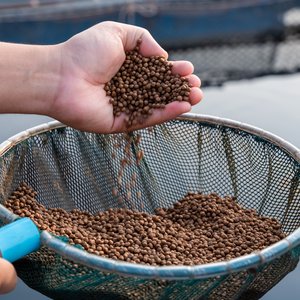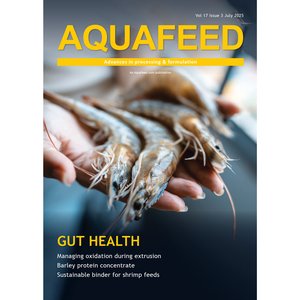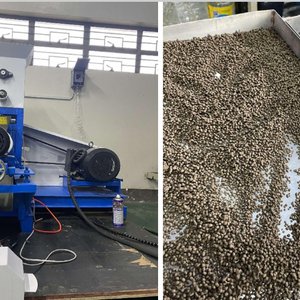Dimitri Sclabos Katevas is an experienced fisheries specialist, offering consulting and brokerage services for krill and other fisheries technology, marketing and product development worldwide.
He may be contacted at:
E-mail: dimitri@sclabos.com; Phone: (+56 2) 273 4966; Fax: (+56 2) 273 0395.
A dangerous new import restriction is gaining ground in the EU, one that will eventually jeopardize the importation and distribution of crustacean meals in the EU, which will have profound effects in North European prawn meals, South Asian and South American shrimp and langoustine meals, and of course on the growing imported volumes of South Antarctic Krill Meals. This is the Fluorine content on crustacean meals. Seems that the Dioxin, heavy metals, PCB and the likes are not enough worries. New demons are needed.
As per Directive 2002/32/EC of the European Parliament and of the Council of May 7th 2002, related to undesirable substances in animal feed, a 500ppm Fluorine max level is being imposed on feeding stuffs of animal origin intended for animal feed from August 1st 2003 onwards. If this directive prevails, this will be the end of the usage of crustacean meals in aqua feeds. With it goes natural pigments in the form of astaxanthine, natural amino acids and fatty acids only found in these products, and a powerful natural palatability effect for aqua feeds.
The Antarctic Krill (Euphausia superba, Dana) shell, a small crustacean captured in the South Antarctic seawaters, has a high natural organic fluorine content being it a very important compound of krill’s body weight. Subsequently, krill meals produced out of South Antarctic krill resource have natural organic fluorine content in the range of 1000-3000 ppm. Krill meals are an important world-class aqua-feed ingredient elaborated mainly from whole Antarctic Krill by few commercial fisheries companies,
The South Antarctic meals made out of krill have been for many many years used as a high-class high-priced aquaculture feed ingredient on salmon, shrimp, tuna and others important hatchery feeds, considering it as a source of protein, energy, natural carotene pigmentation agent, feeding stimulant and others relevant nutritional properties.
Considering the above information, it is of the most importance to establish a higher Fluorine level in krill meals due to its natural and organic source found in Antarctic krill, coming from a non-polluted area as the South Antarctic waters.
Antarctic Krill (Euphausia superba, dana)
Fishing Grounds: This small crustacean is captured in the South Antarctic non-polluted seawaters mainly in the CCAMLR (Commission for the Conservation of Antarctic Marine Living Resources). South Antarctic krill lives only in the open sea (Quetin et al. 1994).
Food Web: The South Antarctic Krill is key in the Antarctic ecosystem food chain due to its great abundance and its central position in the food web. (May and Beddington 1982). The estimated total annual predators’ krill consumption is around 150 – 300 millions tones. (Miller et al., 1989). Humans safely and directly consume several of these species with no reported risk of fluorine contamination. Krill meals are used as one more aqua-grade feed ingredient and it is indirectly fed to humans, being used in small concentrations in such aqua-feeds.
Fluorine in Krill: All krill species contain high levels of natural organic fluorine in their shells (Nicol and Stolp 1991; Soevik and Breakkan 1979; Virtue et al. 1995; Groth 1975). However, as previously indicated, South Antarctic krill is a key food source for a huge number of predators, being fluorine involved in the synthesis of bones and scales (Steffens, W. et al., 1982).
Fluorine content in Krill Meal: Krill meal processing considers whole raw krill nutritive quality, yield, economical and non-pollution aspects. Krill’s growth promoting factors seems to be found in the steroids located in the cephalothorax region, thus available in non-muscle meal (Allahpichay and Shimizu 1985). Therefore, the organic fluorine is concentrated in the South Antarctic Krill Meal in a range of 1000 – 3000 ppm (Steffens, W. et al., 1982; Amended proposal Norwegian Agricultural Inspection Service, 2001; IFOP, 1980).
Krill Meal used on Aquaculture Feeds: Antarctic Krill Meal has been used for many years in aquaculture feeds at an inclusion rate found in the vicinity of 4% depending on each species. It is used as a protein, same as energy and natural pigment carotenes source. It also provides growth promoting factors through krill’s properties found through krill’s special amino acids profile and its feeding stimulant effect.
Aqua feeds using Krill Meal as an ingredient targeting salmon, was found to have a far superior taste while simultaneously did not significantly accumulated krill fluorine in their flesh. (Storbakken, 1988). Similar results were found with trout feeds (Tiews, K. et al., 1981).
Krill resource has also contributed to an increased disease resistance in farmed salmon attributed to krill meal’s salmon immune system improvement (Haig-Brown 1994).
Table 1: Fluorine in Antarctic Krill Meal, Preliminary data
(Personal Report from 2002 season fishing results)
| Catch Coordinate | Sea water | Fluorine | Moisture | |||
| Lot Nº | Date | Latitude (S) | Longitud (W) | Temp. (ºC) | level (ppm) | (%) |
| 14 | Feb-11 | 60º 25´ | 46º 48´ | 0.6 | 1073 | 8.7 |
| 21 | Feb-18 | 60º 30´ | 46º 44´ | 0.8 | 2079 | 7.2 |
| 23 | Feb-22 | 60º 17´ | 46º 29´ | 0.8 | 1705 | 9.4 |
| 27 | Feb-26 | 60º 23´ | 46º 18´ | 0.7 | 1849 | 7.6 |
| 29 | Mar-15 | 60º 26´ | 46º 27´ | 1.0 | 1548 | 7.9 |
| 35 | Mar-22 | 60º 26´ | 46º 39´ | 0.8 | 1493 | 7.6 |
| 46 | Apr-02 | 60º 17´ | 46 º 17´ | 0.6 | 1690 | 6.7 |
For more information on krill, see "The Krill" under Abstracts and Papers in our Feed and Nutrition section. (http://www.aquafeed.com/article.php?id=365)
References
Quetin, L. B., Ross, R. M. and Clarke, A. (1994). Krill energetics: seasonal and environmental aspects of the physiology of Euphausia superba. In Southern Ocean Ecology: the BIOMASS perspective (ed. S. Z. El-Sayed), pp. 165-184. Cambridge: Cambridge University Press.
May, R. M. and Beddington, J. R. (1982). The harvesting of interacting species in a natural ecosystem. Sci. Am. 247
Miller, D. G. M. and Hampton, I. (1989a). Biology and Ecology of the Antarctic Krill (Euphausia superba Dana): a review. BIOMASS Scientific Series 9, 1-66.
Nicol, S. and Stolp, M. (1991). Molting, feeding and fluoride concentration of the Antarctic krill, Euphausia superba Dana. Journal of Crustacean Biology 11, 10-16.
Soevik, T. and Breakkan, O. R. (1979). Fluoride in Antarctic krill (Euphausia superba) and Atlantic krill (Meganyctiphanes norvegica). J. Fish. Res. Bd. Can. 36, 1414-1416.
Virtue, P., Johannes, R. E., Nichols, P. D. and Young, J. W. (1995). Biochemical composition of Nyctiphanes australis and its possible use as an aquaculture feed source: lipids, pigments and fluoride content. Marine Biology 122, 121-128
Groth , E. (1975). An evaluation of the potential for ecological damage by chronic low-level environmental pollution by fluoride. Fluoride 8(4): 224-240.
Steffens, W. , lbrecht, M. , 1982. Krillmehl als Eieeissquelle im Fishfutter. Volstandiger Ersatz von teirischem Protein durch Krilmehl im Forellenfutter. Zeitschrift fur Binnenfishherei DDR 29, 79 – 83.
CCAMLR. Statistical Bulletin (1996, 1997, 1998, 1999, 2000, 2001), Hobart, Australia: Commission For the Conservation of Marine Living Resources.
Allahpichay, I. and Shimizu, C. (1985). Separation of growth promoting factors from non-muscle krill meal of Euphausia superba. Bull. Japanese Soc. Sci. Fish. 51, 945-951.
Norwegian Agricultural Inspection Service (2001). Amended proposal for a Directive on undesirable substances and products in animal nutrition. COM (2000) 861 final.
Storbakken, T. (1988). krill as a potential feed source for salmonids. Aquaculture. 70, 193-205.
Tiews, K. , Manthey, M. , Koops, H. , (1981). The carry-over of fluoride from krill meal pellets into rainbow trout (salmo gairdneri). Archiver fur Fisherewissenschaft 32, 39-42.
Haig-Brown, A. (1994). Going for the krill. In National Fisherman, vol. May 1994, pp. 18-19







